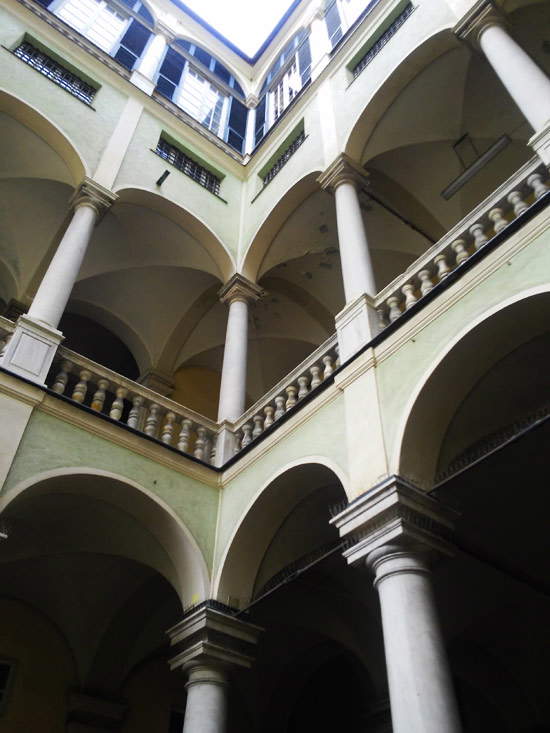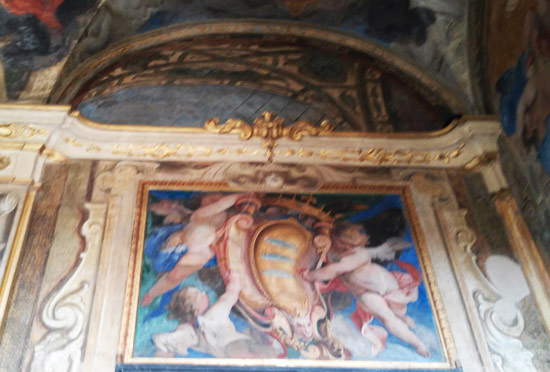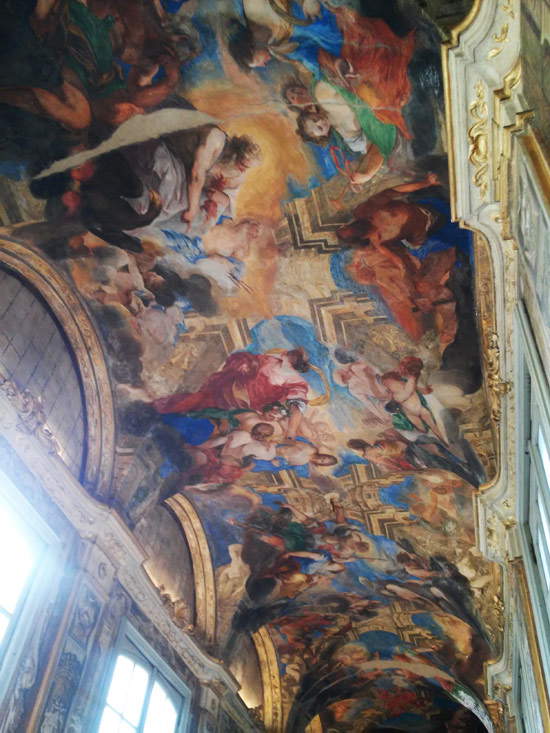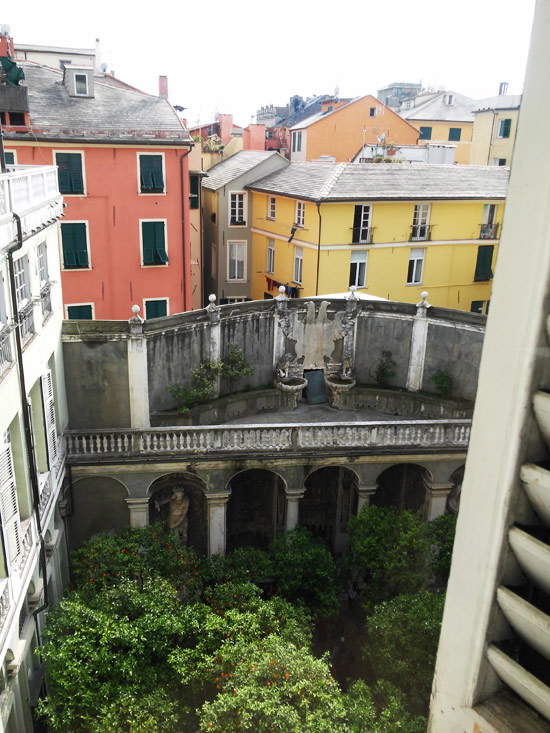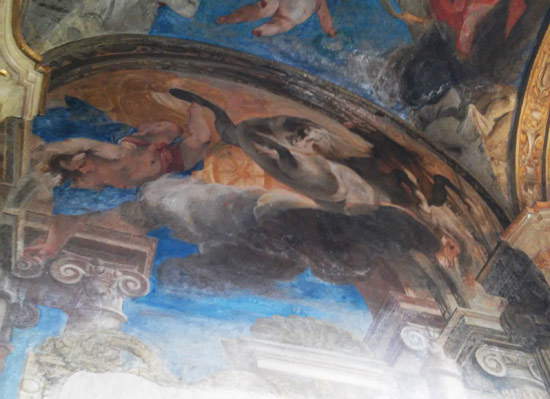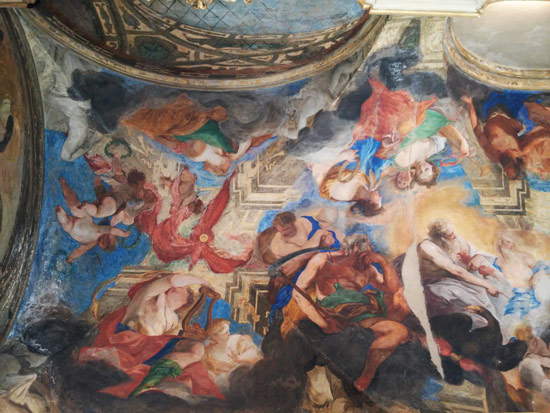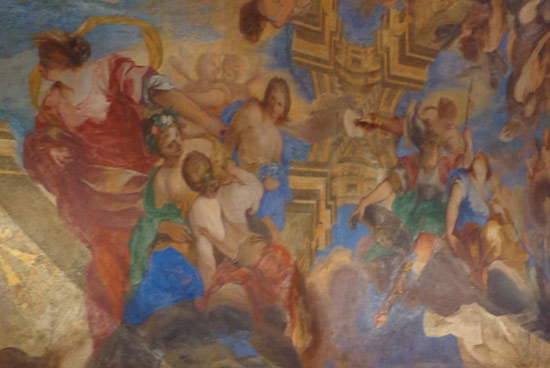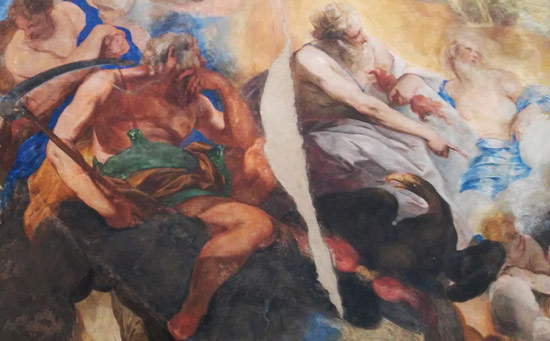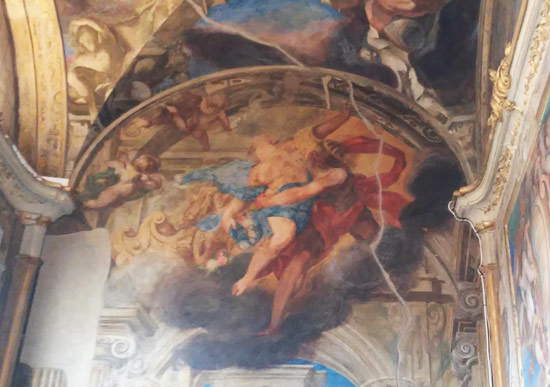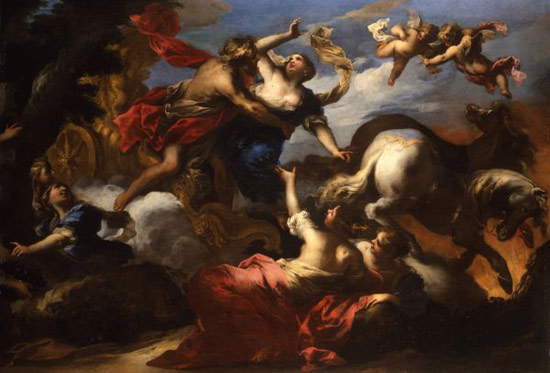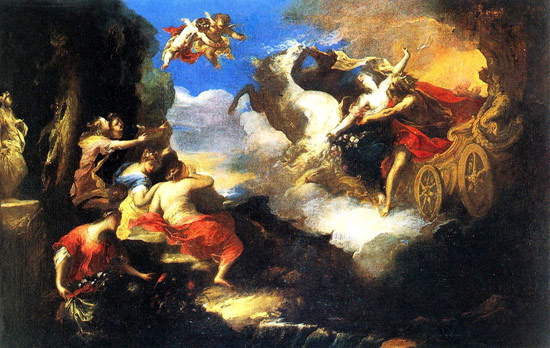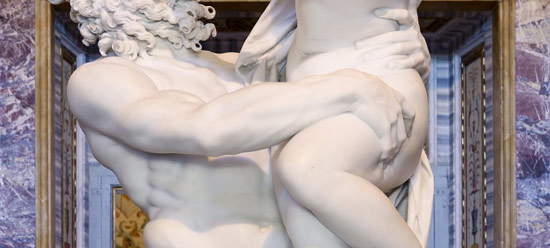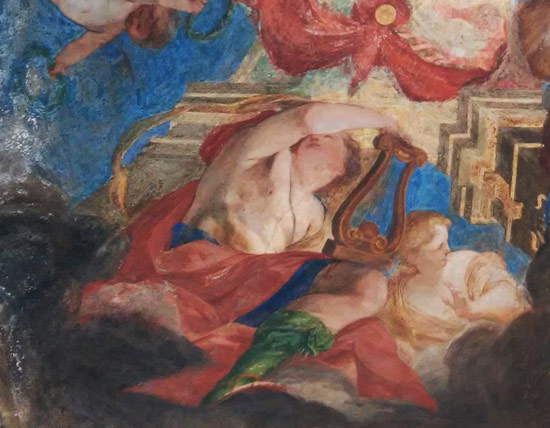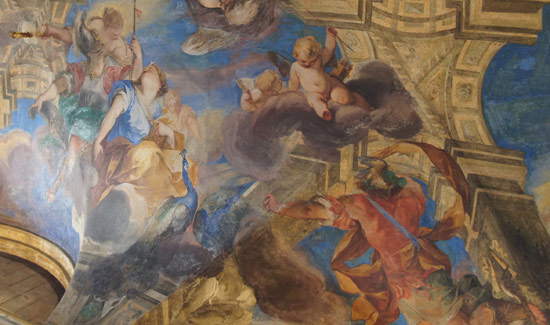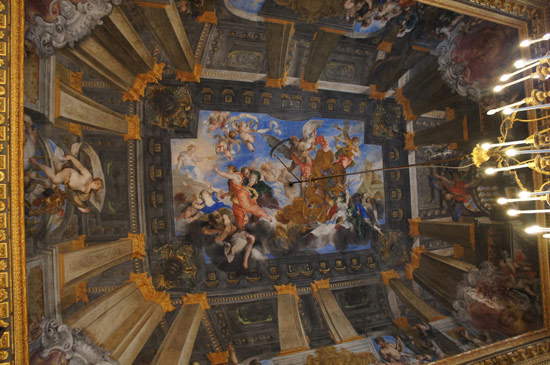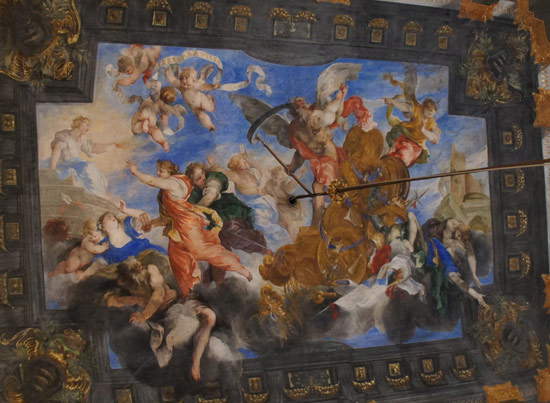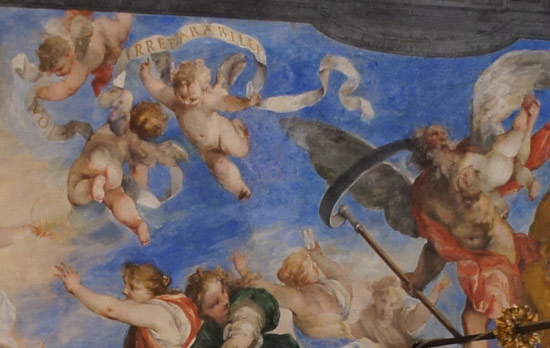by Federico Giannini (Instagram: @federicogiannini1), published on 07/10/2016
Categories: Works and artists
/ Disclaimer
Between 1655 and 1659 Valerio Castello painted a sumptuous cycle of frescoes in Palazzo Balbi-Senarega in Genoa for the Balbi family.
The much credit that Valerius for so many of his worthy works had acquired, moved Signor Francesco Maria Balbi to give him the care of painting in fresco the gallery of his sumptuous palace located in the wide street, which takes its name from this most clear Family. The egregious artist expressed, both in the vault and on the walls, some Deities, with mock statues, groups of putti, and other picturesque fantasies, which met with universal approval, and that mainly of the aforementioned Cavaliere, who gave him ample reward. This is how Raffaele Soprani describes in a few lines, in his Lives of Genoese Artists, the genesis, realization and success of one of the greatest masterpieces of Valerio Castello (Genoa, 1624 - 1659) and of the Genoese seventeenth century as a whole: the cycle of frescoes that adorns the rooms of Palazzo Balbi-Senarega. The building, in the 1650s, still belongs to the Balbi family, one of the most powerful families in Genoa. It is located on the large street that takes its name from the family (and is still called Via Balbi), since this is where their residences were located and much of its current appearance is due to the renovations to which the Balbi themselves had subjected the street in the early seventeenth century. The construction of the palace dated back to 1618: it was designed with the intention of housing the apartments of Giacomo Balbi (and his wife Bettina Senarega, hence the name by which the building is still known today) and the latter’s brother, Pantaleo.
 |
| The double loggia of Palazzo Balbi-Senarega in Genoa as seen from the inner courtyard |
 |
| The Balbi coat of arms frescoed by Valerio Castello |
When Palazzo Balbi-Senarega was being built, Valerio Castello had not yet been born, and he was a young artist when the new owner, Francesco Maria Balbi, summoned him to decorate the halls and drawing rooms of the second piano nobile. It is 1654: Valerio is thirty-one years old but already a successful painter, the highest representative of the Baroque in Genoa. The building, however, had undergone modernization, and a decorative apparatus appropriate to the importance of the palace and the family living here was needed. The iconographic program has a clear objective: to celebrate the power of the Balbi family, evoking their power, qualities, gifts, and activities through various episodes from mythology. The program covers theentire palace: the visitor, already upon entering and finding before him the sculptures of the sumptuous roof garden, must necessarily understand with whom he is dealing. The frescoes commissioned from Valerius Castello are therefore located within this program aimed at exalting the splendor of the Balbi family.
The painter begins with perhaps themost challenging undertaking: frescoing the long gallery above the garden, known today as the Gallery of the Rape of Persephone, because the entire decoration revolves around that episode. The fulcrum of the narrative is the goddess Demeter (Ceres for the Romans), tutelary deity of crops, harvests, agriculture, and the fecundity of the earth: the symbolic reference is not only to the theme of nature generating prosperity, a common thread in the decorations throughout the palace, but also to the wealth of the Balbi family. The narrative begins on the lunette of the entrance wall with a scene depicting the fall of Phaeton, the mythical son of Helios, god of the Sun, who obtained from his father the chance to drive the chariot with which the latter brought light to the earth. However, Phaeton, due to his inexperience, fell into the Eridanus River (identified as the Po). According to some versions of the myth he was electrocuted by Zeus, who came to this decision to prevent the young man from causing further damage to the earth with the chariot of the Sun. Phaeton, in fact, had burned much of the earth’s vegetation, drying it up: the episode, seemingly unrelated to the context, is thus linked to the figure of Demeter who, after Phaeton’s fall, would do her utmost to ensure that the earth would become fertile again. Phaeton is depicted as a young man of handsome appearance as he is ruinously thrown from the chariot, which we see being pulled by a pair of prancing horses: the hero is foreshortened perspective-wise, because Valerius Castello wanted to give us the illusion of witnessing the fall and seeing Phaeton as if he were plunging down upon us who are beneath him. To add to theillusionism of this fresco we have the context within which the episodes are set: a mock marble loggia with powerful and imaginative Baroque architecture, created by the young Andrea Seghizzi (Bologna, 1630 - 1684), who was entrusted with the quadratures, that is, the complex of perspective representations of the mock architectural elements.
 |
| Valerio Castello, Gallery of the Rape of Persephone (1655-1659; frescoes, Genoa, Palazzo Balbi-Senarega) |
 |
| The view of the garden from the Gallery |
 |
| The Fall of Phaeton |
Looking away from Phaeton’s lunette and turning toward the Gallery, we see Demeter (dressed in red, accompanied by some handmaidens and recognizable by the ears of corn adorning her head) appealing directly to her brother Zeus, the father of the gods, whom Valerius Castello depicts seated on a throne of clouds along with Neptune (the god of the sea, with his trident) and Kronos (the latter recognizable by his scythe), accompanied by his eagle symbol, while holding a bundle of lightning: the goddess points to the now unproductive earth, evidently pleading with Zeus to do something. There is another episode that relates to the theme of the barrenness of the earth, this time directly connected to the goddess of the harvest: it is the abduction of her daughter Persephone, who was led to the underworld by Hades, god of the Underworld, who had fallen in love with her and wanted to make her his bride. Demeter would have liked to bring her daughter back to earth: however, Persephone, having eaten some pomegranate seeds, was forced to remain in the Underworld, because according to mythology those who fed on the fruits of the underworld had no way out. Zeus acted as a “mediator” between Demeter and Hades, and an agreement was reached: since Persephone had eaten only six seeds, she would remain for six months of the year in the Underworld, and for the remaining six months she would be allowed to be reunited with her mother. The myth was designed with the purpose of explaining thealternation of the seasons: autumn and winter during the six months Persephone spent in the underworld, spring and summer during the time when she returned to earth and the latter was again covered with flowers and fruit. In the episode depicted by the Genoese painter, Hades, arriving cloaked in a black cloud, clutches tightly to himself a struggling Persephone in despair in order to lead her with him to his own realm. The narrative scheme, the poses of the characters (for example, that of Hades, with his muscular arm encircling Persephone around the waist to hold her down) recalls that of other “Persephone’s Rats” that Valerius Castello had painted before: this is the case, for example, with the canvas also preserved in Genoa but in the Palazzo Reale, and especially with the painting in the Palazzo Barberini in Rome, where the poses of the characters are almost identical to those in the Palazzo Reale. This was, in fact, a theme that the artist had tackled several times and whose iconographic tradition, in the Baroque sphere, went back to Gian Lorenzo Bernini’s famous Rape of Persephone, now in Rome at the Galleria Borghese (the motif of Pluto’s arm stretching out to forcefully grasp the young girl also appears in Bernini).
 |
| Another view of the Gallery of the Rape of Persephone. <a href=’https://commons.wikimedia.org/wiki/File:Palazzo_Balbi-Senarega_Genoa_03.JPG’ target=’_blank’ rel=’nofollow’ Credit |
 |
| A detail of the Gallery’s vault |
 |
| On the left, Demeter (red robe) and Persephone playing with her companions. Right, from left, Athena, Aphrodite and Artemis |
 |
| From left: Kronos, Zeus, Neptune |
 |
| The Rape of Persephone |
 |
| Valerio Castello, The Rape of Persephone (c. 1650; oil on canvas, 148 x 217 cm; Genoa, Palazzo Reale) |
 |
| Valerio Castello, The Rape of Persephone (c. 1650; oil on canvas, 128 x 151 cm; Rome, Palazzo Barberini, Galleria Nazionale d’Arte Antica) |
 |
| Gian Lorenzo Bernini, The Rape of Persephone, detail (1621-1622; marble, 255 cm; Rome, Galleria Borghese). Credit |
Returning to the fresco that decorates the vaults of the Gallery, the narrative includes all the figures involved in the Persephone myth, along with other deities that Valerio Castello inserts with the intention of helping the viewer distinguish the protagonists of the story. It opens with the figure of Apollo, who is holding his lyre and whom we see in the first vault, the one near the wall with the Fall of Phaeton: not far from him, on the opposite side of the scene, we have some of the Muses. The group, being the ones to whom mythology demoted the protection of the arts and poetry, has the function of “introducing,” almost as if they were reciting a lyric or poem, the entire narrative. On the vault that immediately precedes the exit of the gallery, we haveDionysus pointing with his right arm to Eros, the Cupid of the Romans, who is preparing the arrows to shoot at the god of the Underworld to make him fall in love with Persephone. Hades is arriving surrounded by the usual black clouds: he is depicted from behind, recognizable by the same crown he wears in the lunette, and we find him opposite the figure of Demeter. Not far away, three goddesses, namely Athena, Aphrodite and Artemis, are discussing among themselves: the connections between these goddesses and the abduction incident find reason to exist if we speculate that Valerius Castello’s literary sources, in addition to Ovid’s Metamorphoses, may include a poem by Claudianus, De raptu Proserpinae, in which Athena and Artemis pick flowers together with Persephone at the moment when the young girl is abducted by Hades, and Aphrodite urges Eros to make Hades enamored. The painter would then paint, according to the identification proposed by art historian Ezia Gavazza, some characters who appear in the story after Persephone’s disappearance: they are the daughters of Celaeus and Metanira, whom Demeter had met while looking for her daughter, and who would lead her to the home of her parents, who would offer hospitality to the goddess. The latter, in reciprocation, would offer the gift of divinity to another son of Celeus and Metanira, Demophon: on the opposite wall we have the depiction of Demeter nursing the baby. Again, we have the figure of the nymph Arethusa, the first to reveal to Demeter the abduction of Persephone: we find her close to the god Aeolus. It is then worth mentioning the figure of Hermes, the messenger of the gods, charged by Zeus to bring Persephone back to earth. In addition to the lunette, the young girl is also depicted in the main fresco: we see her close to her mother, playing carefree games with some companions.
 |
| On the left Aeolus, on the right Hades. <a href=’https://commons.wikimedia.org/wiki/File:Palazzo_Balbi-Senarega_Genoa_20.JPG’ target=’_blank’ rel=’nofollow’ Credit |
 |
| Apollo with a muse |
 |
| Three muses and, on the left, the god Hephaestus |
 |
| On the left is the group with Athena, Aphrodite and Artemis. In the center Eros, on the lower right Hermes. <a href=’https://commons.wikimedia.org/wiki/File:Palazzo_Balbi-Senarega_Genoa_20.JPG’ target=’_blank’ rel=’nofollow’ Credit |
The figure of Time, symbolized by Chronos in the vault of the gallery, is the great protagonist of the large and scenic fresco that adorns and characterizes (to the point of giving the room its name) the ceiling of the Hall of the Chariot of Time. A powerful depiction, where the architecture struggles to contain the figures, for there are hands and clouds invading the false cornices: a foretaste of the inventions that would be definitively introduced by another great genius of Baroque fresco painting, a Genoese himself, Giovanni Battista Gaulli known as Baciccio, who fifteen years later, in his Triumph of the Name of Jesus done in Rome, would probably remember cues and suggestions he had received in his own hometown, which by the time of Valerio Castello had in fact become one of the capitals of Baroque decoration.
It is again Raffaele Soprani who gives us indications on how to interpret the figures of this magniloquent allegory: Expressed Valerio in the prefaced hall the chariot of time drawn by the four ages of man: and above the cornice other symbolic things, corresponding to the same ages. Opposite the principal entrance door there has Fame, and various other figures: there has Fortune, and other Deities, which give entire fulfillment to the emblem. The chariot is represented dynamically in its overwhelming advance that does not stop in front of anything, to give a particularly effective visual representation of the inexorable passage of time. And if the allegory were not sufficiently clear, making it even more manifest are the putti in the upper left-hand corner, which bear a cartouche with the inscription Volat irreparabile (to fly inevitably is, of course, time), an expression derived from Virgil’s Georgics. However, this is not a fresco with negative tones, as the aforementioned Ezia Gavazza points out: in fact, in the upper left corner we have a winged figure pointing to the allegory ofEternity. The latter is on the far left, seated on a marble throne, and dispenses to the figures pulling the chariot of time the symbols of eternity (the circle) and glory (the crown). Eternity and glory are thus the ultimate ends of the passage of time, and of course they are also the goals to which the Balbi family aspires.
 |
| Valerio Castello, Hall of the Chariot of Time (1655-1659; frescoes; Genoa, Palazzo Balbi-Senarega). <a href=’https://commons.wikimedia.org/wiki/File:Palazzo_Balbi-Senarega_Genoa_25.JPG’ target=’_blank’ rel=’nofollow’ Credit |
 |
| Detail of the Hall of the Chariot of Time. <a href=’https://commons.wikimedia.org/wiki/File:Palazzo_Balbi-Senarega_Genoa_25.JPG’ target=’_blank’ rel=’nofollow’ Credit |
 |
| The putti with the cartouche and the figure of Time. <a href=’https://commons.wikimedia.org/wiki/File:Palazzo_Balbi-Senarega_Genoa_25.JPG’ target=’_blank’ rel=’nofollow’ Credit |
Francesco Maria Balbi, after seeing the results of the first two works by Valerio Castello and Andrea Sighizzi, was enthusiastic, and as Soprani also attests, he decided to entrust the great painter and his collaborator with the decoration of two more rooms, namely, the Hall of Peace and the Hall of Leda: When that work was finished, the genius of occupying our painter did not already cease in Mr. Balbi. Who, however, gave him the care of adorning two other halls. Valerius effigyed in the first the three Graces with various putti, and medals around them, and in the second, four fables of Diana, and other Deities. In those salons also worked Sighizzi, who did the exterior ornaments, and perspectives there. In the Hall of Peace, raising our eyes, the sumptuous spectacle of an illusionistically pierced ceiling will appear before us: the remarkable architectures of Sighizzi open, forming almost a four-leaf clover, on a clear sky, as if there really were nothing above our heads, but only the vault of heaven. In the sky appear the figures of three deities, identified as Peace,Cheerfulness andAbundance. The figures occupy the lobes of the four-leaf clover with very high spatial wisdom: our eye follows two diagonals, triggered by the central figure of Peace, who holds an olive branch in her hand while waiting for the two putti coming from the right, together with the dove, to bring her another. The first diagonal is precisely the one that starts from these two putti and continues, on the opposite side, with the figure of Cheerfulness spreading flowers on the cupids rushing, on the lower left, toward her, completing the imaginary line that begins on the upper right. The second diagonal has its center in the olive branch held up by Peace and its ends in the figure of Abundance, seated to the left of Peace, resting her hand on a cornucopia, and in the putti fluttering in the upper left. The particularly charged decoration continues in the arches, which are also open to the clear blue sky and overlooked by putti bearing all sorts of gifts. The columns, cornice, and spandrels are filled with statues of deities, decorative elements (garlands, shells, festoons), and the faux marbles do not have a single inch that is not ornamented. The image crowns the iconographic program by presenting us with the three qualities that should have accompanied the work of the Balbi family.
 |
| Valerio Castello, Hall of Peace (1657-1659; frescoes; Genoa, Palazzo Balbi-Senarega). <a href=’https://commons.wikimedia.org/wiki/File:Palazzo_Balbi-Senarega_Genoa_27.JPG’ target=’_blank’ rel=’nofollow’ Credit |
 |
| Detail of the Hall of Peace. <a href=’https://commons.wikimedia.org/wiki/File:Palazzo_Balbi-Senarega_Genoa_27.JPG’ target=’_blank’ rel=’nofollow’ Credit |
Valerio Castello’s interventions in the Palace of Francesco Balbi end in the Hall of Leda, a drawing room that was part of the oldest core of the Palace (thus dating from 1618-1620), in need of renovations: here, too, gaudy gilded architecture simulates the opening of an oculus within which the Genoese artist placed the figure of Leda, heroine of Greek mythology, possessed by Zeus who, in order to unite with her, had taken the form of a swan (the Dioscuri, Castor and Pollux would later be born from the union). The candid figure of Leda, carried in flight by three cherubs with the complicity of the father of the gods who had already transformed into a swan, contrasts with the unrestrained pageantry of the decorative apparatus, another important testimony to the particular (albeit up-to-date) tastes of the Balbi family.
Valerio Castello’s life ended, in circumstances not yet well clarified, in 1659: the artist was only thirty-five years old and his work in Palazzo Balbi would be completed by other artists, who would be entrusted with the continuation of the cycle with other scenes decorating further sumptuous rooms. Today Palazzo Balbi-Senarega is home to the Faculty of Humanities of theUniversity of Genoa, which took it over in 1972 from its last owners. The Gallery of the Rape of Persephone, for example, houses a section of the library, while adjacent lounges house reading rooms, computer rooms, and offices. A visit to this priceless masterpiece of the Italian Baroque therefore falls within a special context, because we are in an active place, and it is necessary to take into account that the needs of those who live here on a daily basis are far different from those who enter to admire the masterpieces of Valerio Castello (and others). But the beauty of Genoa (and of Italy in general) is also this: to see that masterpieces that have marked our art history inside buildings that, perhaps often with different functions than the original ones, are still lived in.
Reference bibliography
- Marzia Cataldi Gallo, Luca Leoncini, Camillo Manzitti, Daniele Sanguineti (eds.), Valerio Castello, 1624-1659: modern genius, exhibition catalog (Genoa, Museo di Palazzo Reale - Teatro del Falcone, February 15-June 15, 2008), Skira, 2008
- Camillo Manzitti, Valerio Castello, Allemandi, 2004
- Ezia Gavazza, The painted space: the great Genoese fresco in the 1600s, SAGEP, 1989
Warning: the translation into English of the original Italian article was created using automatic tools.
We undertake to review all articles, but we do not guarantee the total absence of inaccuracies in the translation due to the program. You can
find the original by clicking on the ITA button. If you find any mistake,please contact us.
